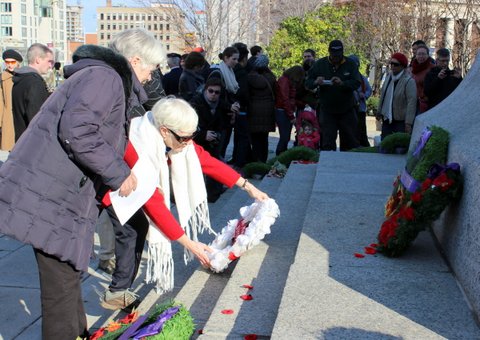There was a little-noticed twist to this year’s Remembrance Day ceremonies at the National War Memorial in Ottawa. About an hour after the end of the official speeches, jet fighter flybys and canon salutes, a small group of people gathered at the memorial to lay a wreath decorated with white poppies to accompany the red ones that had been placed there earlier.
“I will be wearing both the red poppy and the white today,” said Heather Menzies of Ottawa, a member of the Voice of Women for Peace and of the White Poppy Coalition. “The red to honour Nathan Cirillo who was killed standing guard at Canada’s War Memorial, and the white to honour the compassion in the face of violence showed [those] passers by who rushed forward to help.”
Menzies, who is also the incoming chair of The Writers’ Union of Canada, added: “I wear the red poppy for those who step forward when war becomes necessary, and the white to keep asking why: why war should ever be necessary.”
She spoke for perhaps five minutes. Her remarks were respectful toward military veterans — her father was one — even while she raised points that had gone largely unrecognized in earlier official remarks by the Governor General and other speakers.
Menzies was surrounded by a small group of about 20 supporters and a larger number of people who had remained on site following the official ceremonies. She was treated respectfully by everyone there with the exception of one middle-aged male heckler who was ignored and soon left.
Civiilian deaths
Elizabeth Whitmore, another speaker at the event, said that it is often forgotten that most wars kill more civilians than combatants. (There was in this year’s official ceremonies virtually no mention of civilian deaths and casualties).
Estimates are that 17 million people died in the First World War, about 10 million military personnel and about 7 million civilians. In the Second World War, the estimated death toll was 60 million. Civilian deaths are calculated to have been 38 million. Those deaths outnumbered those of the 22 million military who died.
White poppy coalition
A note from the White Poppy Coalition that was circulated to supporters prior to the event described the ceremony as “an alternative and comprehensive means of remembering all those who died and are dying, injured, or displaced by war: soldier and civilian alike. The white poppy is a symbol for the alternative to war as a means of conflict resolution. It is a pledge to work to end war and the suffering it causes.”
White poppies were first worn on Armistice Day 1933 by members of the Co-operative Women’s Guild in Great Britain. The white poppy idea arose from the wives, mothers, sisters and lovers of the men who had died and been injured in World War One. The women were increasingly concerned about the likelihood of another war and chose the white poppy as a symbol of a pledge to work for peace and in opposition to war.
War Memorial rededicated
At this year’s official Remembrance Day ceremony, the National War Memorial was rededicated by Governor General David Johnston. Princess Anne was in attendance and read a brief message from her mother, Queen Elizabeth. The war memorial was first dedicated by King George VI in May 1939, to mark the sacrifices of those who fought in the First World War. The Second World War began just months later.
PeaceQuest
A group called PeaceQuest says that although it respects the military sacrifices made by Canadians, it believes that the government should also rededicate the Peace Tower on Parliament Hill. And if the government won’t, then citizens should.
The group, which began in Kingston and has working groups in Ottawa and several other cities, says it wants to provide a “counter narrative’ to the government’s attempts to paint Canada as a militaristic nation. Their intention is to encourage people to look at Canada in terms that go beyond attempts to portray us as a warrior nation.




